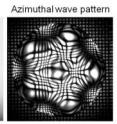High-speed camera captures dancing droplets for scientific 'photo album,' study
The splash from rain hitting a windowpane or printer ink hitting paper all comes down to tiny droplets hitting a surface, and what each of those droplets does. Cornell University researchers have produced a high-resolution "photo album" of more than 30 shapes an oscillated drop of water can take. The results, a fundamental insight into how droplets behave, could have applications in everything from inkjet printing to microfluidics. Susan Daniel, assistant professor of chemical and biomolecular engineering, led the study, to be published in Physical Review E, Aug. 9. First author Chun-Ti Chang, a Cornell graduate student, designed and performed the experiments, which involved a high-speed, high-resolution camera. Paul Steen, professor of chemical and biomolecular engineering, and his former student, Josh Bostwick, led the theoretical portion of the study.
"What is really special about this study is the high-quality imaging we were able to capture of these oscillating droplets," Daniel said. "We created an imaging platform where we could look at the drop from the top, to enable us to see the characteristic shapes better than anyone has before."
The imaging platform, which Chang has named the "Omniview" because of the different angles at which the droplet can be observed, consists of a glass slide, the droplet sitting on top, and a 50-micron-square metal mesh, like a window screen, underneath. A light is shined through the mesh holes, and deflection of the drop's surface refracts the light, which is seen as a deformation of the mesh and captured by a high-speed camera.
The researchers mechanically oscillated the drops at varying frequencies, and observed and recorded their movements. The oscillation can be likened to when a violin string is plucked; certain natural frequencies correspond to a given length of string, the same way certain frequencies correspond to the shape of a drop of a specific size.
The researchers created a detailed table of droplet shapes according to frequency, as well as comparing these results to previous theoretical predictions involving the dynamics of oscillating droplets. Classical theories don't capture the dynamics entirely, but new predictions, made by collaborators Steen and Bostwick, take into account the physical effect of the solid substrate in contact with the droplet and match the images in the photo album.
The researchers also observed that some of the droplets take on multiple shapes when vibrated with a single driving frequency -- akin to physicists observing two different energy states simultaneously in an excited molecule.
"Without the high-speed imaging, we wouldn't have been able to see the drops exhibiting these kinds of mixed behaviors," Daniel said.
The detailed, clear table of oscillating drop modes should lend insight into further fundamental studies, as well as a host of applications, Daniel said. For example, NASA is interested in understanding how droplets on surfaces move in low gravity. And in high-resolution printing, the spread of a drop as it touches a surface will dictate image resolution. The surface chemistry of the roller, printer and ink will have profound effects on the technology.
More images and animations: https://cornell.app.box.com/droplets
Source: Cornell University
Other sources
- Video: Dance of the Water Dropletsfrom Science NOWThu, 8 Aug 2013, 17:20:05 UTC
- High-speed camera captures dancing droplets for scientific 'photo album'from Science DailyTue, 6 Aug 2013, 20:20:16 UTC
- High-speed camera captures dancing droplets for scientific 'photo album,' study (w/ Video)from PhysorgTue, 6 Aug 2013, 17:20:33 UTC
- High-Speed Camera Captures Dancing Droplets for Scientific 'Photo Album,' Studyfrom Newswise - ScinewsTue, 6 Aug 2013, 17:20:08 UTC
